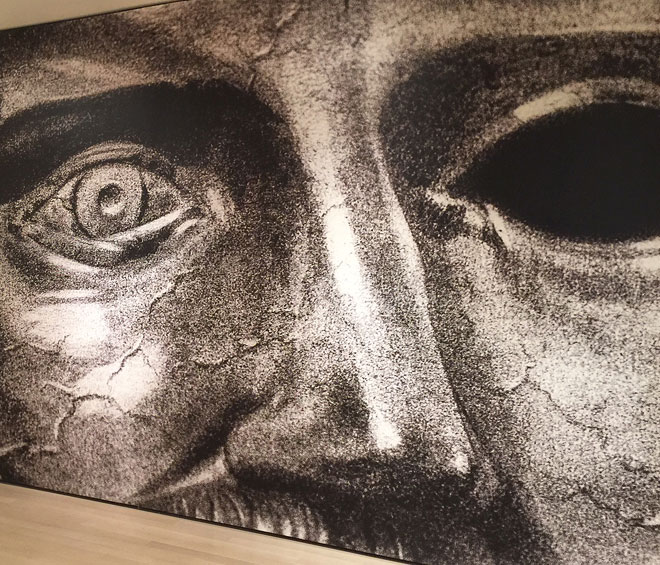
Museum of Modern Art, New York
18 March – 19 August 2018
by JILL SPALDING
All those years of my early career at British Vogue I had worked next to (and on travel shoots with) the top of what were then, by definition, fashion photographers. I remember marvelling at how well they executed the narrative’s brief; crisp black and whites for Paco Rabanne’s hard-edged line, dreamy pastels for Zandra Rhodes’s wispy creations, neons for the madcap cutups lining Carnaby Street. I remember, too, the wonder of Norman Parkinson’s staged scenarios – who will ever forget that shot of Veruschka, tanned, oiled and stretched out on the snow? But not ever did I think of those magazine fantasies as art, nor even Helmut Newton’s sexualised fashion-disguised body shoots that sold out every issue they appeared in. Did I ever think to save the proofs of the Cecil Beaton, David Bailey, Herb Ritts, Barry Lategan shoots I had commissioned? Although some rose above all the others, none reached the stratosphere of what we called art. These were fashion shoots, after all, and fashion itself was but ephemera, a vanity of the moment.
I confess that this prejudice slipped over to the photo-journalists I came to know later. Searing, those war pictures by Robert Capa! Rousing, those street-takes by Henri Cartier-Bresson, Martine Franck’s poignant portraits of the bypassed and elderly. I remember, too, when I first saw the book recording the high-low moment of MoMA’s ground-splitting 1955 survey The Family of Man. (A happy coincidence that the museum has just reissued it, together with a scholarly catalogue analysis of the show’s unrivalled impact – it beat even King Tut with a largest-ever nine million global viewership.) No contest. Here were deeply involving pictures of a visceral America – farmers, barbers, shopkeepers and postal workers finding love, fighting anomie and grinding through the Depression, all in it together, trapped in amber by the storied likes of Dorothea Lange and Ansel Adams. Gladdening, saddening, wrenching, but, for those of us brought up to write Art with a capital, the image was still only “caught”, the salient talent that of close observation not creation.
As for the day’s studio photography, all thought Penn’s still life takes on lipstick and flowers gorgeous – cut out of back issues, we would use them for book covers – and admired his portraits. Richard Avedon, who famously said that a likeness transformed by a photograph is not a fact but an opinion, imparted a candid intimacy to portraiture that tore through the pages like the first day of spring. But those proofs? No one kept them. (Vogue’s photo archive was established only decades later.) Even the carefully positioned and lit photographs by the likes of bona fide artists such as Edward Steichen and Man Ray struck me as experiments – time-off investigations into how to revive their painting and sculpture. Their brilliance was never questioned. Just their value. As understood then, the genius of a great photograph was to recalibrate the tired eye. But fine art? Art was feeling! Art was tactile! Painting was Art; sculpture was Art; click-and-print works on paper remained clever exercises in seeing.
Not so fast-forward through William Eggleston’s saturated dye-transfer takes on American suburbia that introduced colour photography as a serious medium; Nan Goldin’s wrenching psychedelic photo-journals of lives torn and wasted; Thomas Struth’s magnified manipulations of venues we all had trouped through. All were skilful and not without talent, but left a nagging sense of “they set it up, framed it and pressed the button”. Still no understanding of what art had to do with it. Shouldn’t art flow from mind and eye through the hand? Must not the artist shape, carve, piece or limn a work? Galleries didn’t think so. And, as prices for a Robert Mapplethorpe leapt from $500 (£350) to $5,000 and those for a Man Ray rivalled a Rembrandt, nor did the museums. Marcel Duchamp had flipped the model with his urinal; if it hangs in a museum, “it’s art”.
For myself, although I never noted the turning point, the needle moved up with the first elaborate interventions. John Baldessari’s collaged and airbrush “doctored” tabloid photos; James Casebere’s paper reconstructions, carefully shaped, lit and photographed to convey the cavernous ruins of time. Andreas Gursky’s computer-perfected hyperreal panoramas; Vera Luter’s 24-hour-exposure transformations of postcard sites into opera sets; David Hockney’s multiperspective collaged Polaroids. Wondrous those carefully built-up compilations by Gilbert and George; Wolfgang Tillmans’ fluid abstractions; Louise Lawler’s reworked images scaled up to murals or down to paperweights to give them multiple lives; Ahmed Mater’s manipulated landscapes, reimagined and rephotographed to suggest an irretrievable paradise, and Richard Koci Hernandez’s iPhone scenarios that sliced off surreal takes on an ordinary day.
A generational shift has brought yet bolder manoeuvres; photo/video mashups, digital distortion and the acrobatics performed to simulate texture by applying paint, fabric, food to the original image – each intervention photographed and layered on the preceding one to build up an illusion that, nonetheless, restricted to one plane behind glass, remained two dimensional. Art? Could be.
This long lead-in is to pinpoint the needle’s full swing as offered by this iteration of MoMA’s two-yearly exercise in new photography. Ever of great interest in that it reflects the museum’s curatorial thinking about what is happening now of note in the medium, the show is always well attended, conscientiously reviewed and, relating to its effect on the sales of those included, a trend-setter.
Edition 2018 accommodates 80 new works and, as is now mandatory, a healthy diversity. The widened spectrum of nationality, ethnicity and gender encompasses nine countries and extends our belated appreciation of the African-American sensibility to the African continent. In line with MoMA’s practice to theme each iteration, this year’s header is “Being”, a broad catch-all for work that “captures what it means to be human”. Fortunately, a qualifier adds that “many challenge the conventions of photographic portraiture” because this selection, compared with the acute intimacy showcased in Real Worlds; Brassaï, Arbus, Goldin (showing until 3 September at the Los Angeles Museum of Contemporary Art) presents as deliberately detached.
More compelling is MoMA assistant curator Lucy Gallun’s larger proposal that photography has made a significant leap into, if not a new era, a dramatically wider understanding of where a photograph can go. Into the bathwater with the tintype and gum bichromate on platinum have gone Ektacolor and the lightbox transparency. Sinking, too, are the film stocks and analogue cameras that produced them. It is not clear to me whether the digitally powered medium replacing them should even be thought of as photography. As exhibited here for the most part, the initial image, composed largely with the tools of cut, paste and save, and transformed seemingly ad infinitum by computer interventions, has been worked into another reality altogether.
Not all has been jettisoned – the silver gelatin print seems to be making a comeback – and those portraits set against Photoshopped backgrounds are real people. Rather, unleashed by technology, it is the artist’s eye that has moved. Engaging the Jasper Johns mantra “Do something to it. Do something else to it”, much of this new work has nudged the medium forward with skills that call on virtual realities and artificial intelligence.
The primary concern remains pictorial. And there is no getting away now from “issues”, so race, sexuality, inequality and repression are all addressed here. But the larger achievement of this mastered technology is a complex aesthetic that subsumes agenda to an expression of universal truths that, as seen in a fair portion of the works on view, can only be called art.
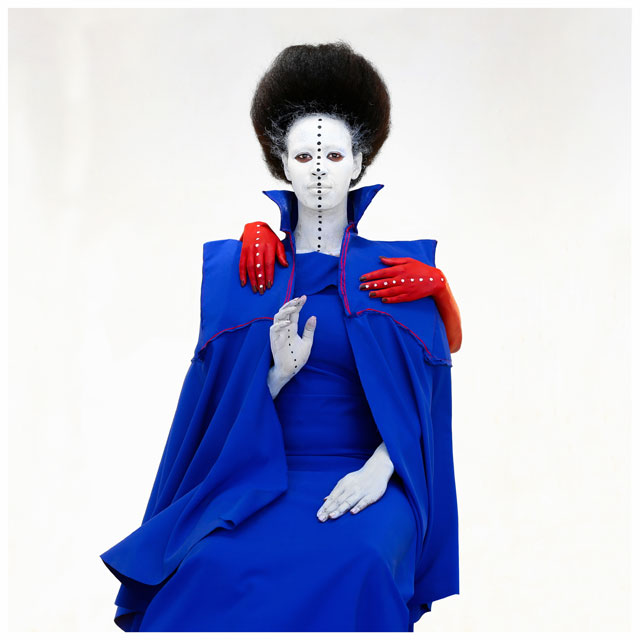
Aïda Muluneh. All in One, 2016. Pigmented inkjet print, 31 1/2 × 31 1/2 in (80 × 80 cm). Courtesy the artist and David Krut Projects. © 2018 Aïda Muluneh.
Their ages ranging from 31 to 44, only 17 artists have been tapped, but each is given a large space and multi-work voice. Printing on Sunset Hot Press Rag, Aïda Muluneh (b1974, Ethiopia) leads in with elaborately costumed portraits that engage face paint and razzled backdrops to evoke native African ceremonials. As with a colour-field painting, the punch comes from the contrast of hot and cool as émigré angst spools out from a diptych of a passerby on a train (The Departure 2016) and a sequence of vivid print-stills to project the impassive dignity of the Masai warrior.
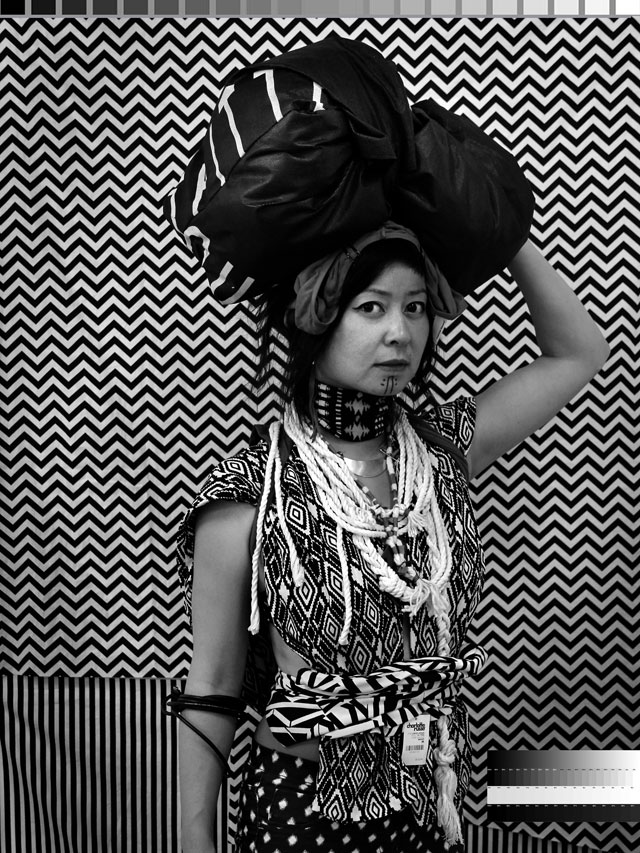
Stephanie Syjuco. Cargo Cults: Head Bundle, 2013-16. Pigmented inkjet print, 40 x 30 in (101.6 x 76.2 cm). Courtesy the artist and Catharine Clark Gallery, San Francisco and Ryan Lee Gallery, New York. © 2018 Stephanie Syjuco.
Stephanie Syjuco (b1974, Philippines), too, sets costumed portraits against digitally rendered backdrops, but to reverse effect. Challenging the authenticity of the west’s understanding of ethnicity, her 2013-16 Cargo Cults sendups of travellers’ ethnographic depictions (achieved with new garments still showing the price tag, both to flag the conceit and let her return them) question the very premise of identity.
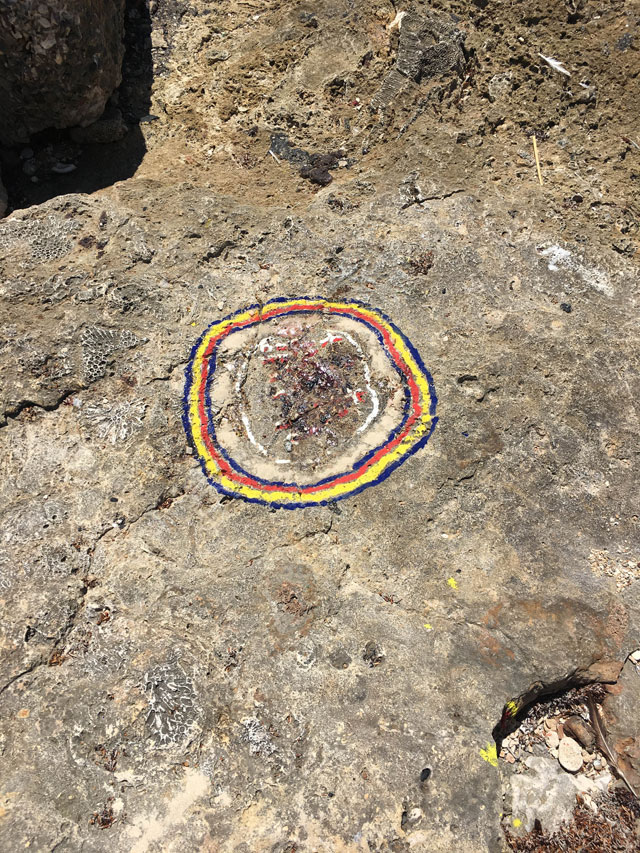
Harold Mendez. Consent not to be a single being, 2017-18. Pigmented inkjet print, 36 × 27 in (91.4 × 68.6 cm). Courtesy the artist and Patron Gallery, Chicago. © 2018 Harold Mendez.
Harold Mendez (b1977, US) lays down the gauntlet of Sin Nombre (2017-18) a tour-de-force panorama blown up from a small, scratched glass slide found in Havana of an everyman rider embarked on an everywhere journey that is rendered movingly immediate with cotton, crayon, graphite and spray enamel on a ball-grained aluminium plate.
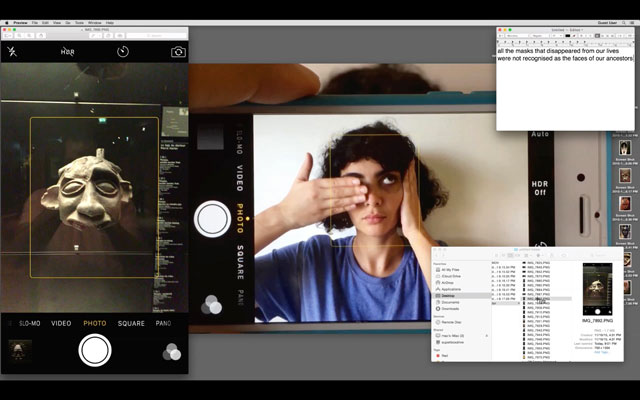
Yazan Khalili. Hiding our faces like a dancing wind, 2016 (still). Video (colour, no sound), 7 min, 30 sec. Courtesy the artist and Lawrie Shabibi, Dubai. © 2018 Yazan Khalili.
Following on from Yayoi Kusama’s infinity-room meditations and Iván Navarro’s down-the-rabbit hole illusions, Yazan Khalili (b1981, Syria) morphs self into soul with a visually challenging computer screen video of a photograph of a video of a streamed image of a woman taking a selfie on her iPhone (Hiding Our Faces Like a Dancing Wind, 2014).
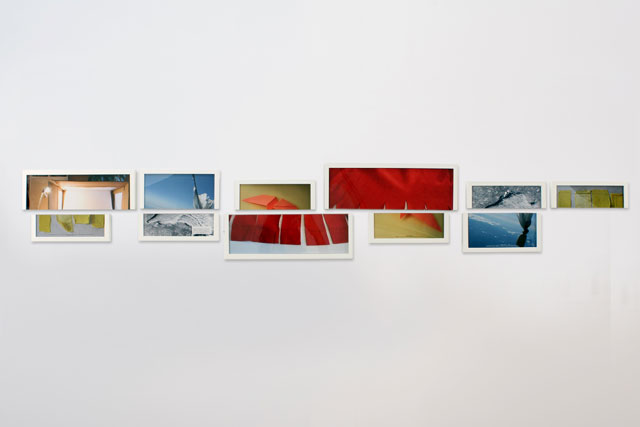
Shilpa Gupta. Untitled, 2014. Pigmented inkjet prints in split frames, 18 × 103 in (45.7 × 261.6 cm). Courtesy the artist and Galleria Continua, San Gimignano, Beijing, Les Moulins, and Habana. © 2018 Shilpa Gupta.
Best known for interactive installations worked from materials culled from the streets of Mumbai (think crochet-covered bricks and bottles filled with blood that have passed down through a train), Shilpa Gupta (b1976, India) doubles down on the decomposed image. Strung out horizontally like misaligned Donald Judds, four Untitled (2014) pigmented inkjet prints depict people whose names have been, or have had to be, changed, their faces cut up and reassembled to give them new visual identities.
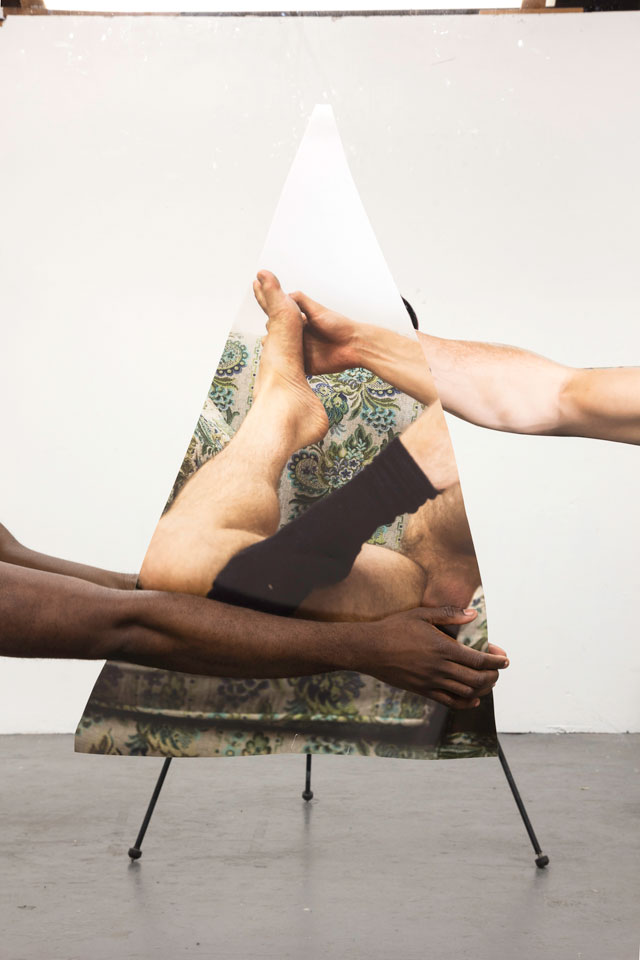
Paul Mpagi Sepuya. Mirror Study (4R2A0857), 2016. Pigmented inkjet print, 51 × 34 in (129.5 × 86.4 cm). The Museum of Modern Art, New York. Fund for the Twenty-First Century. © 2018 Paul Magi Sepuya.
Paul Mpagi Sepuya (b1982, US) may have relocated to Los Angeles, but he sits with his back to the view. Mining an inner landscape, he frames drapery and sourced materials to contrast the emotional impact of charged spaces either filled with, or emptied of, bodies. Providing a resolution of sorts, Mirror Study (4R2A0857) (2016) achieves harmony with a squared composition of black arms thrust through the triangular hand-drawn plane of a tripod to embrace disembodied white limbs.
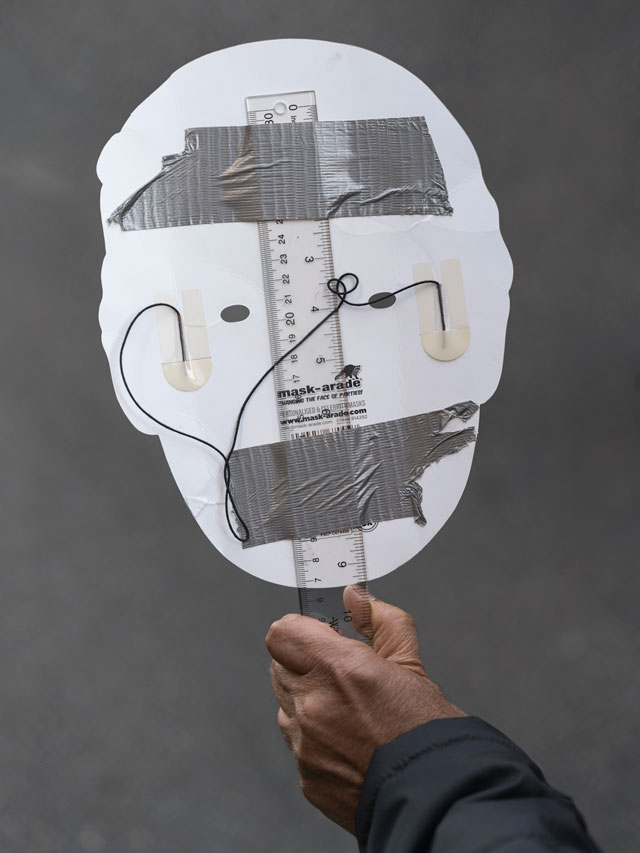
Matthew Connors. Mask in Reverse, 2016. Pigmented inkjet print, 44 × 33 in (111.8 × 83.8 cm). Courtesy the artist © 2018 Matthew Connors.
In striking contrast, US artist Matthew Connors’ pastoral images of life in North Korea subvert the idyll with sly interventions. On close viewing, a plein-air landscape, Pyongyang (2016), is framed like a master painting but reframed as a doctored photograph of a fabricated nirvana by a seemingly accidental double exposure that left the photographer’s hand in the image. Unanimous Desire, part of a collective work hung like a decomposed painting, also conveys emotions that cannot be spoken, but with a series of built or composed multimedia installations.
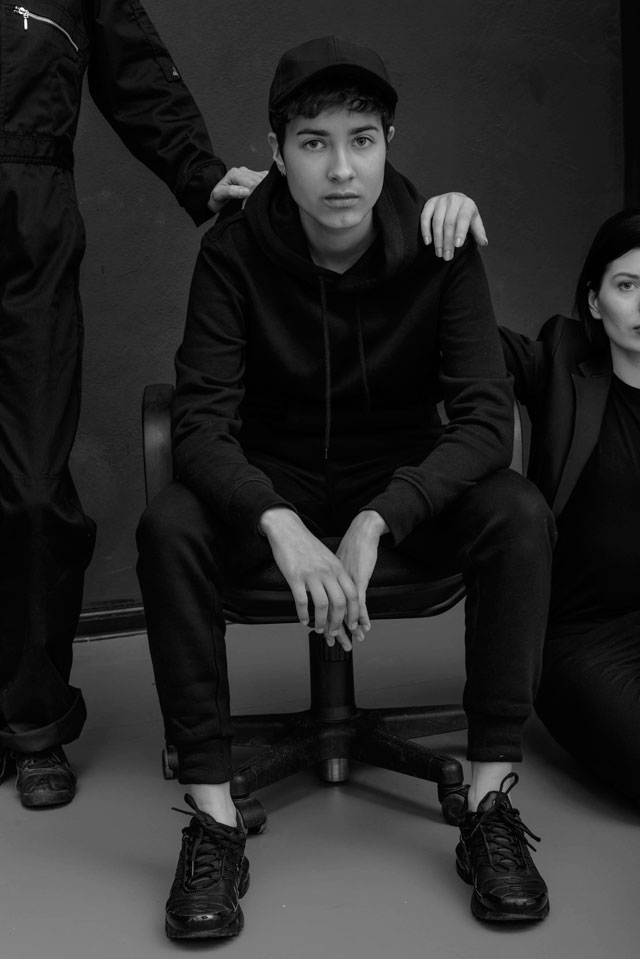
Andrzej Steinbach. Untitled from the series Gesellschaft beginnt mit drei, 2017. Inkjet print, 35 7/16 × 23 5/8 in (90 × 60 cm). Courtesy the artist and Galerie Conradi, Hamburg and Brussels. © 2018 Andrzej Steinbach.
The arresting black-and white images by Andrzej Steinbach (German; b1983, Poland), drawn from a series, Untitled (2016) addresses split identity by juxtaposing black-and-white portraits of two men and a woman, each cropped to move the extremities of the one on to the next for a Corps Exquis exercise that alternately strips away and adds to our accepted view of humanity.
Engaging visual alchemy, a trio of photo-collages (2018) by Adelita Husni-Bey (b1985, Italy), proposed as student workshop projections of MoMA’s dystopian future in the aftermath of catastrophe, wrest an enigmatic prediction from manipulated simulations of a quattrocento nativity, a biblical parable and a Zurbarán.
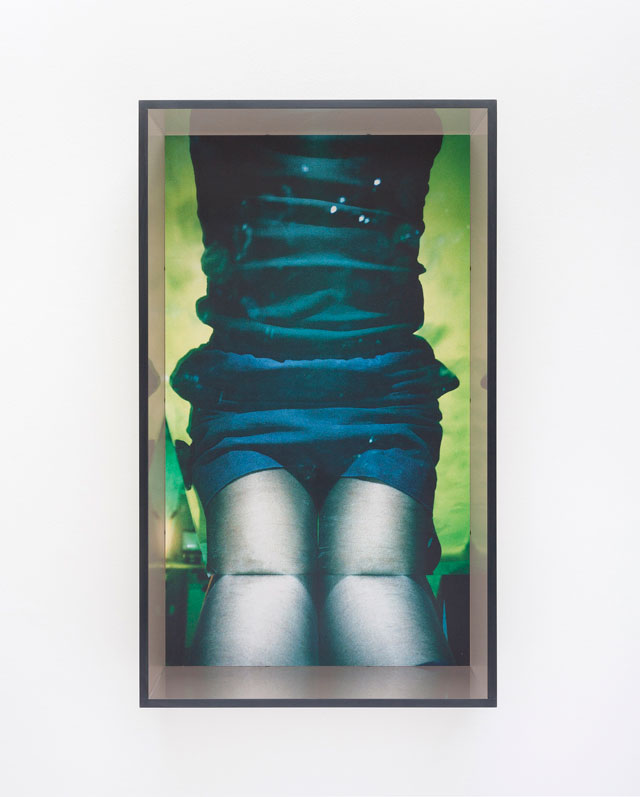
B. Ingrid Olson. Felt Angle, box for standing. 2017. UV printed MDF, PVA size, Plexiglas, screws, 31 1/2 × 18 1/2 × 6 in (80 × 47 × 15.2 cm). The Museum of Modern Art, New York. Fund for the Twenty-First Century © 2018 B. Ingrid Olson.
B Ingrid Olson (b1987, US) startles with surrealist Beuys-inflected UVM-printed pdfs (all 2017) of headless self-portraits girdled, felt-wrapped or sculpted with light and screwed to the wall behind Plexiglas.
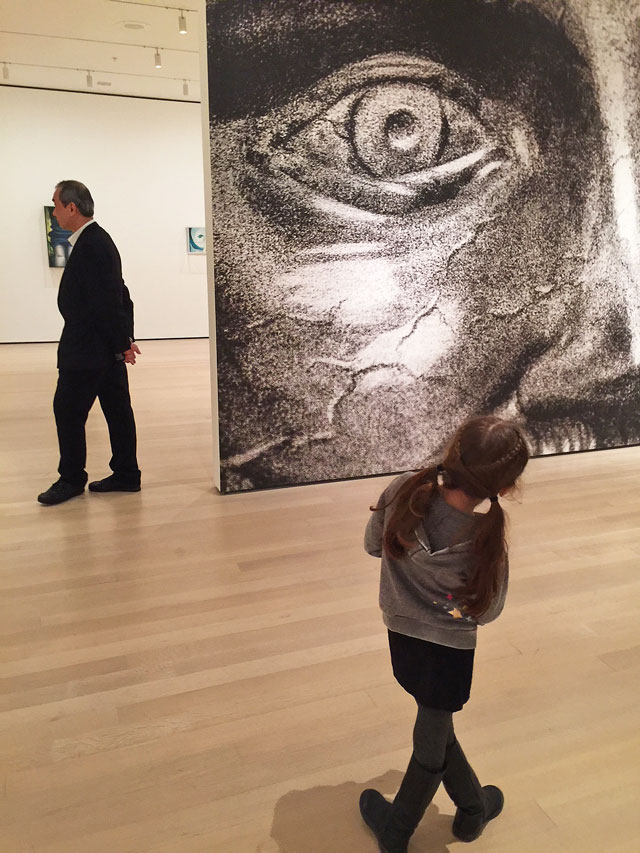
Sofia Borges. Theatre, or Cave, 2014. UV-printed wallpaper, printed 2018. Installation view. Photograph: Jill Spalding.
If one artist can be said to dominate, it is Brazil’s Sofia Borges (b1984) with mesmerising mural-scale, seemingly 3D-printed pigmented inkjet prints of Olmec-dimension stone heads that are so realistic as to command “do not touch” signs. Viewers coming across Theatre, or Cave (2014) step so far back to absorb its entirety as to occasion collisions with those standing behind them. Monumentality is “huge” now, of course – seen across disciplines in such efforts as Anselm Kiefer’s magisterial installations commissioned for his Warehouse by collector Martin Margulies, and the grandiosity aesthetic triggered by the colossi built for Burning Man. But Borges is after something of a different order altogether. Approach a giant redwood, stand under the Sphinx, make a rubbing of a temple frieze and you are, of course, moved by their size, but equally by their texture – the deep materiality of the bark, sand or marble. By suffusing this illusion of texture into a photograph – you must be fully alert to see that Painting, Brain and Face (2017), is not actually a tapestry – Borges has profoundly and irrevocably moved photography beyond reportage, beyond craft, beyond the quick eye and smart idea to a level of creativity that directs thought through hand to produce from a flat image the complex emotion that reads as art.
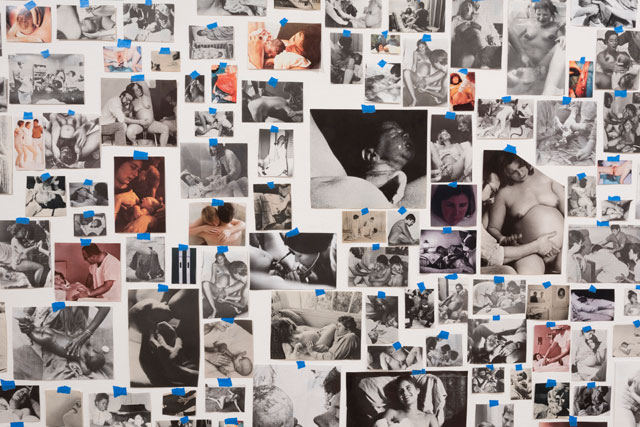
Carmen Winant. My Birth (detail), 2018. Site-specific installation of found images, tape. The Museum of Modern Art, New York. Photograph: Martin Seck. © 2018 Carmen Winant.
Not all the work selected has been successfully manipulated. And My Birth (2018, a facile, two-wall compilation of found photographs by Carmen Winant (b1983, US) depicting women closeup in childbirth doesn’t even belong here. The two wall-length composites of more than 2,000 tiny “I could have taken them” snaps mined from estate sales, health providers and discarded libraries must have been included more for the show’s theme than its reveal, so tired is the format that intrigued when first peeled off the throwaway camera but that now, like those unedited photos that collect on your iPhone, tests viewer patience with its deluge of undigested information.
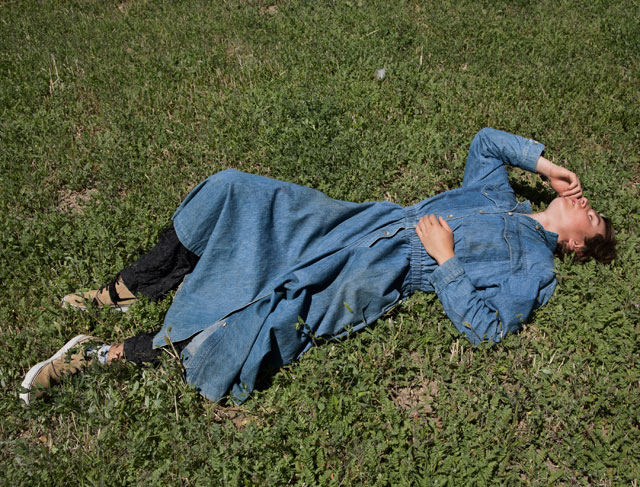
Sam Contis. Denim Dress, 2014. Pigmented inkjet print, 31 5/8 × 41 11/16 in (80.3 × 105.9 cm). The Museum of Modern Art, New York. Acquired through the generosity of Thomas and Susan Dunn © 2018 Sam Contis.
On the other hand, in context, the gelatin silver prints by veteran photographer Sam Contis (b1982, US), do read as a departure. See, in Denim Dress, how the tranquil American iconography of girl-sprawled-out-in-field jumps the frame when you realise the girl is a boy; and in Junction 2015, how the mythic forms and long shadows of the American west are worked into surreal compositions that speak as poignantly of human longing as has any sculpture or painting. Which begs the question, have I been asking the wrong question? Should I have understood photography as a High Art all along? Or has this bold new work taken the medium to a place that the last denier can no longer deny?
What is certain is that the eye, ever seeking a rush, will keep asking more of photographs as new technologies seduce. Tomorrow’s question is how will the artist wrangle from the post-analogue-computer’s elastic neural membrane an image at once personal and urgently universal? The question for the day after tomorrow is shall the photographic conceit of “image” vanish altogether and with it both photograph and the “art of photography”? Meanwhile, visit this uneven but gripping exhibition to see where MoMA places the vernacular today.